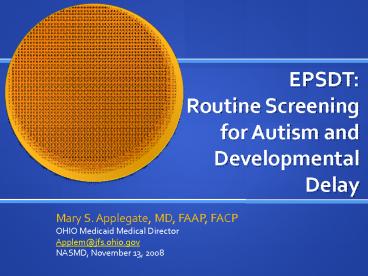EPSDT: Routine Screening for Autism and Developmental Delay - PowerPoint PPT Presentation
1 / 23
Title:
EPSDT: Routine Screening for Autism and Developmental Delay
Description:
20% of all visits to the pediatrician are developmental or behavioral in nature. ... Pediatrician Recognition of. Developmental &Behavioral Problems. JV ... – PowerPoint PPT presentation
Number of Views:27
Avg rating:3.0/5.0
Title: EPSDT: Routine Screening for Autism and Developmental Delay
1
EPSDT Routine Screening for Autism and
Developmental Delay
Mary S. Applegate, MD, FAAP, FACP OHIO Medicaid
Medical Director Applem_at_jfs.ohio.gov NASMD,
November 13, 2008
2
Disease Lifecycle
3
3 Levels of Prevention
4
EPSDT
- Primary Secondary Prevention EP
- Most Secondary some Tertiary Prevention SD
- Some Secondary all Tertiary Prevention T
5
Rationale for Routine Screening
- 16 of children have a developmental /or
behavioral disorder - Newacheck, PW, Strickland, B, Shonkoff, JP, et
al. An epidemiologic profile of children with
special health care needs. Pediatrics 1998
102117. - Only 30 are identified prior to school entry,
signifying missed opportunities for Early
Intervention - Palfrey, JS, Singer, JD, Walker, DK, Butler, JA.
Early identification of children's special needs
a study in five metropolitan communities. J
Pediatr 1987 111651.
6
Benefits of Routine Screening
- Early detection, diagnosis and treatment
- Parents become more engaged supported in
childs health care - Parents can match the childs abilities to
developmentally appropriate activities - Early Intervention leads to better health
outcomes, improved school performance and may
prevent secondary problems
7
Downside of Routine Screening
- What if the child has a false positive test?
- Studies have shown that many have other needs
that are identified and can be addressed through
Early Intervention - What if the child has a false negative test?
- A repeat screen can be done.
8
The Scientific Evidence Behind Screening
- 3 criteria are important in deciding what
conditions to include in a periodic health
examination screen (USPTF) - 1). Burden of suffering
- 2). Quality of the screening test
- 3). Quality (effectiveness, safety cost) of
intervention for primary or secondary prevention. - NOTE The prevalence and incidence of the
condition is important in screening
9
Yield of Repeat Screening
10
Biases in Screening
- Lead time (Time of detection by screening vs.
usual method) - Length time (Time from screen to symptoms)
- Compliance bias
11
Lead Time Bias
12
Length Time Bias
13
Compliance Bias
14
Characteristics of the Ideal Screen
- Valid
- Reliable
- Sensitive
- Specific
- Requires little time or preparation
- Inexpensive
- Accessible
15
Definitions
- Positive Predictive Value (PPV) A/AB
- Negative Predictive Value (NPV) D/CD
- Accuracy AD/ABCD
- Sensitivity A/AC
- Specificity D/BD
16
Current Conditions A Snapshot of Care
ESchor, Rethinking Well-child Care, Pediatrics
114, 2004
17
Current Conditions
- 20 of all visits to the pediatrician are
developmental or behavioral in nature. - 80 of parental concerns are accurate
(Olson, AC, 2003) - American Academy of Pediatrics (AAP) Policy 2006
recommends routine surveillance and standardized
developmental and behavioral screening - Effective screening is not done routinely by most
practitioners (15) - Practitioners, agencies and states have struggled
with how to operationalize the recommendation
18
Current conditions Surveillance vs. Screening
- Surveillance A flexible, continuous process in
which knowledgeable professionals perform skilled
observations of children during child health care
(in consultation with families, specialists,
child care providers, etc) - a mile wide, an inch deep
19
Surveillance vs. Screening
- Screening A brief, objective, validated test
performed at specific points in time or if there
is a concern to differentiate children that are
probably OK vs. those who need additional
investigation - a mile deep, an inch wide
- Objectivity matters e.g. Temperature taking
- Screening compliments continuous surveillance
20
Pediatrician Recognition ofDevelopmental
Behavioral Problems
JV Lavigne et.al. Pediatrics. Mar.1993
91(3)649-55
21
Detection Rates
22
Screening Benefits
- Screening works (better than surveillance
alone) - Facilitates access to services
- Encourages communication
- Cost effectiveness possible? (based on Early
Intervention studies) - Improved family satisfaction
23
Barriers to Routine Screening
- Expense related to tools, training, office flow
etc - Time, time, time
- Culture of trusting own tools vs. new tools, wait
see - Knowledge access to tools methods
- What to do with falsely or - tests
- Coding and billing issues lack of uniform
reimbursement - Limited referral resources complex processes
involved
24
Other Considerations
- What happens after a positive screen?
- What therapies are accessible?
- What therapies have evidence to suggest outcomes
are improved? - What outcomes are meaningful as a medical
benefit? - Who has responsibility for which aspects of care?
Medical care providers, teachers, parents, mental
health personnel, public health?
25
Other Considerations
- Several different subspecialist types may assist
in highly variable ways with the definitive
diagnosis and/or treatment. How could we help
clinicians establish best practice? - If States adopt the AAP/Bright Futures
periodicity schedule of screening, how do we
resolve the fact that it will still take years to
obtain widespread adoption by the health care
workforce? - Recognize that routine mental health and drug
and alcohol screens will likely follow. Are
there additional implications for those
populations?
26
Other Considerations
- How does the emphasis on Autism screening
compare to other pediatric conditions for which
we screen? Is it more important than vision,
hearing dental conditions? - (all of which have convincing clinical outcomes
cost- effectiveness data) - How would the anticipated fiscal impact of such
screening affect other services?
27
Other Considerations
- Voices for Children Focus Group Study noted that
parents did not feel developmental screening
should be mandated, citing fear of labeling a
child for life.
28
Special Thanks
- TN AAP/TEIS
- OhioHealth/Riverside Methodist Hospitals Library
- OHP
- MMD Colleagues
- AHRQ
- NASMD































